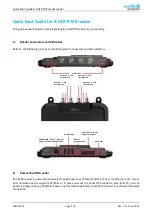
NAVIS NavDP 4000. Operation Manual
S
— Status 0–9 (0 — No reply (not tracking transponder), 1 — Other error, do not use, 2 — Range only, 3–8 — TBD, 9
— Valid Status)
hh
— Checksum
Example
$PSXRAD,00,104853.01,10,1,01,69.40,1.0,360.00,1.0,+0.00,1.0,+0.00,20,9*33
Taut Wire System
Type
Data
Comments
Taut Wire
Outboard angle
α
, right an-
gle
β
, Length, available for
DP status
The system receives the data from Taut
Wire in the form of PTW-message.
PTW Taut Wire Message
The message format:
$--PTW,aaa.aa,bbb.bb,s,xx,nnn.n*hh
where:
aaa.aa
— Outboard angle
bbb.bb
— Right angle
s
— Status (‘A’ -available, ‘N’-n/a)
xx
— Error code
nnn.n
— Length (from zero-length pos)
hh
— Checksum
Example
$PCPTW,-72.22,-81.40,A,00,876.1*03
D.3
VDR Data Standard
This section provides a list of NMEA-messages used for data transmition to the Voyage Data Recorder (VDR), and a
brief description of the message formats.
Descriptions of the message fields refer to the following modes:
– Operational Modes (AP, DP, Bridge) — see Section 2.1, page 22;
– Control Modes (Auto HDG, Track HDG, etc.) — see Sections 9.2, page 161 and 9.3, page 165.
ALA Message: Set Detail Alarm Condition
The message format:
$RCALA,134352.18,OT,DP,,1703,H,A,A|CPU_A_ACTIVE*4D
where
hhmmss.ss
— Event time
aa
— System indicator of an original alarm source
aa
— Subsystem equipment indicator of an original alarm source
xx
— An instance number of an equipment/unit/item (not used)
xxx
— Type of alarm
291
Doc. 000.JDP-10000-OME, rev.3.3.13/“2102.$–17A-Advanced”
















































